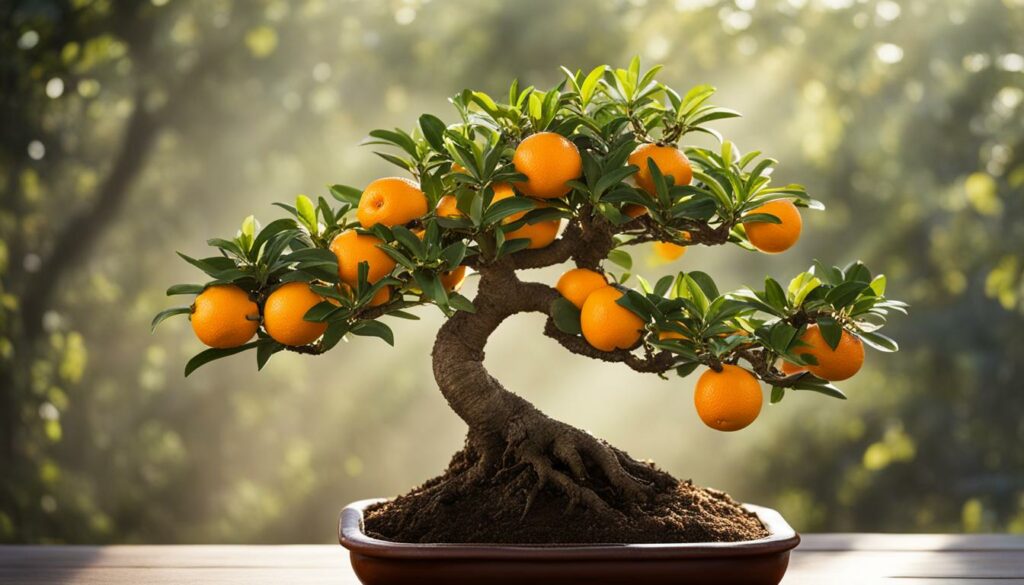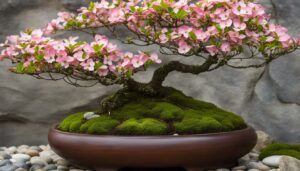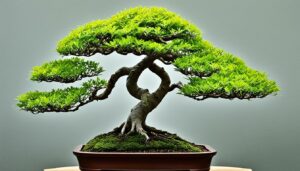Welcome to our comprehensive guide on Citrus Bonsai, a unique and fragrant addition to any gardener’s collection. As you may know, Bonsai trees are miniature versions of larger trees, and Citrus Bonsai encompass a range of species within the citrus family. These miniaturized citrus trees are not only beautiful but also functional as they produce fruits that you can harvest and enjoy. In this guide, you will learn about different species of Citrus Bonsai, how to care for them, and the art of pruning and shaping to create a botanical masterpiece.
Key Takeaways
- Citrus Bonsai are miniature versions of citrus trees that produce fruits.
- There are different species of Citrus Bonsai, such as lemon bonsai.
- Proper care, including watering, sunlight, temperature, and soil considerations, is essential for healthy Citrus Bonsai.
- The art of pruning and shaping Citrus Bonsai is crucial for creating beautiful forms.
- Citrus Bonsai can be displayed creatively, and they are considered a living work of art.
Introduction to Citrus Bonsai
Are you looking for a unique and functional addition to your Bonsai garden? Look no further than Citrus Bonsai. These miniaturized citrus trees are not only beautiful but also functional, producing fragrant fruits that can be used in cooking and baking.
As with other bonsai trees, Citrus Bonsai requires careful and precise care to maintain their health and longevity. It is essential to understand the concept of fruiting bonsai to ensure the successful cultivation of your miniature citrus tree.
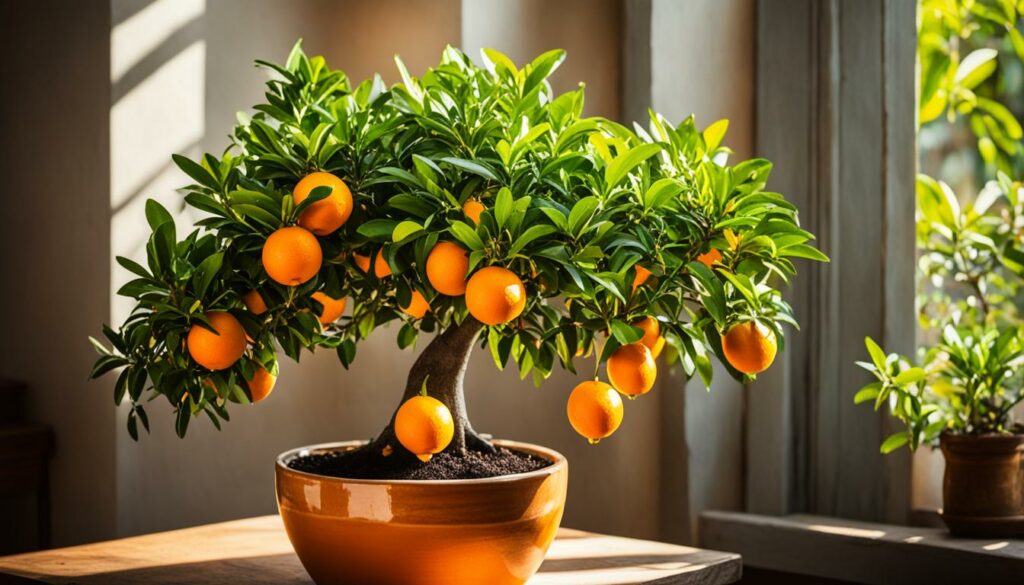
Choosing the Right Citrus Bonsai Species
When it comes to choosing the right Citrus Bonsai species, there are several factors to consider, such as your location, climate, and personal preferences. Some popular Citrus Bonsai species are Meyer Lemon, Calamondin Orange, and Blood Orange.
Meyer Lemon: This versatile lemon bonsai is known for its fragrant and flavorful fruit, which can be used in a variety of culinary dishes. It’s also prized for its attractive and compact size, making it a popular choice for indoor gardening.
Calamondin Orange: This miniature orange tree species is known for its fragrant white flowers and small, sour oranges that are often used in marmalades and jams. It’s a great choice for indoor display due to its compact size and ornamental appeal.
Blood Orange: This vibrant citrus Bonsai species is prized for its juicy and colorful fruit, which has a deep red pulp. It’s also a popular choice for its decorative appeal, with its striking foliage and ornamental bark.
To choose the right Citrus Bonsai species, consider the climate and weather conditions of your location. Make sure the species you choose is suited to your situation to ensure growth and longevity. Consider the size and shape of the tree, as well as its fruit-bearing potential. Research each species and speak to experienced gardeners before making your final decision.
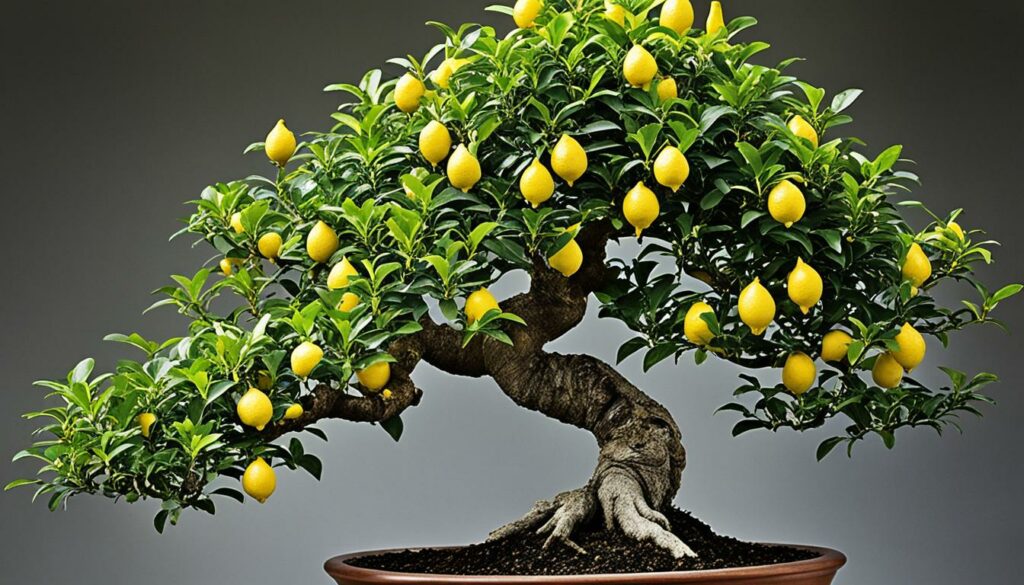
The Art of Pruning and Shaping Citrus Bonsai
Citrus Bonsai offer a great canvas for bonsai enthusiasts to demonstrate their creativity with shaping and pruning techniques. Pruning Citrus Bonsai is essential for maintaining their size and shape, and encouraging new growth.
The goal of shaping a Citrus Bonsai tree is to create a miniature version of a full-grown tree while preserving its natural beauty. When beginning your shaping process, it’s essential to maintain the tree’s proportions by cutting branches in a way that maintains a balanced structure. In the case of Citrus Bonsai, it’s best to focus on the low branches and remove any that cross or grow into each other.
Shaping a Citrus Bonsai tree requires frequent pruning to control the tree’s growth and maintain its size. You can achieve this by cutting off the tips of new growth regularly. Doing this will encourage the tree’s branches to develop smaller leaves and fuller foliage. It also provides an invitation to new buds to form and strengthen the tree’s structure.
When pruning Citrus Bonsai, it’s best to use sharp and clean tools to prevent any damage to the tree and to avoid diseases. The ideal time to prune your Citrus Bonsai is during spring, when the tree begins its active growth.
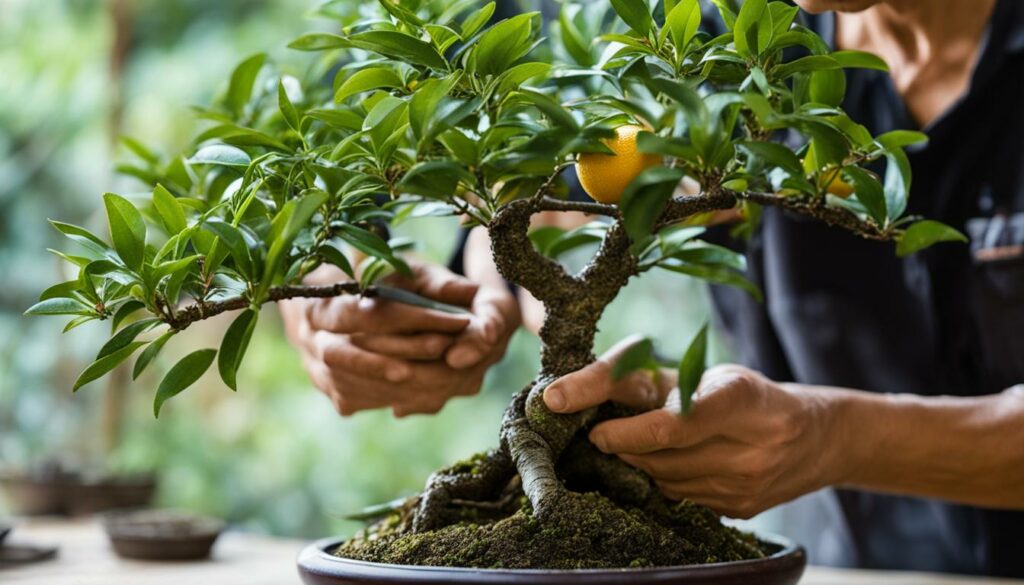
Shaping Techniques
Citrus Bonsai can take various shapes like cascade, geometry, and broom. You can use wiring as a technique to direct the tree’s branches to form the desired shape. It’s important, however, not to keep the wire in place for too long as it can cause damage to the tree’s bark. The ideal time to remove the wire is after three to six months or when the tree’s growing season ends.
The Importance of Maintaining Size and Aesthetics
Maintaining the size of your Citrus Bonsai is crucial to ensure it remains in proportion and aesthetically pleasing. Any branches that grow too fast should be pruned or wired to ensure they’re in line with the tree’s size and shape. This ensures that the tree maintains its beauty and artistic appeal.
The shaping and pruning process for Citrus Bonsai is an art form that requires patience, creativity, and technique. With dedication and practice, you can make your miniature Citrus Bonsai into a stunning masterpiece that will be admired by all.
Understanding Citrus Bonsai Care Requirements
As you embark on your journey of Citrus Bonsai cultivation, it is crucial to understand the specific care requirements of these miniature trees to ensure their health and longevity. Following are the essential aspects of Citrus Bonsai care:
Watering
Watering is one of the most critical aspects of Citrus Bonsai care. These trees require consistent and adequate moisture levels to prevent the roots from drying, but overwatering can cause root rot. A general rule of thumb is to water your Citrus Bonsai thoroughly but only when the soil’s top layer feels dry to the touch. Be mindful of the pot’s drainage holes, ensuring excess water can escape.
Sunlight
Citrus Bonsai trees thrive in bright and indirect sunlight, preferably with at least six hours of daily exposure. Avoid exposing your Citrus Bonsai to harsh and direct sunlight, which can scorch the leaves and stunt their growth. Arrange your miniature citrus trees in a location with optimal light levels, such as a south-facing window or a patio.
Temperature
Citrus Bonsai trees prefer warm and stable temperatures between 60°F to 80°F, with moderate humidity levels. Avoid exposing your miniature citrus tree to sudden temperature fluctuations or drafty locations, which can damage its foliage and growth. Consider placing your Citrus Bonsai on a tray of pebbles and water to increase the humidity levels around it.
Soil
Citrus Bonsai trees require well-draining and nutrient-rich soil that retains moisture without becoming waterlogged. A combination of peat moss, perlite, and sand is an ideal potting mix for Citrus Bonsai trees. Ensure you repot your miniature citrus tree at least once every two years to maintain proper soil conditions and root health.
Understanding and adhering to the specific care requirements of your Citrus Bonsai trees can lead to a healthy, thriving, and fragrant miniature citrus garden that will impress and delight you and your visitors.
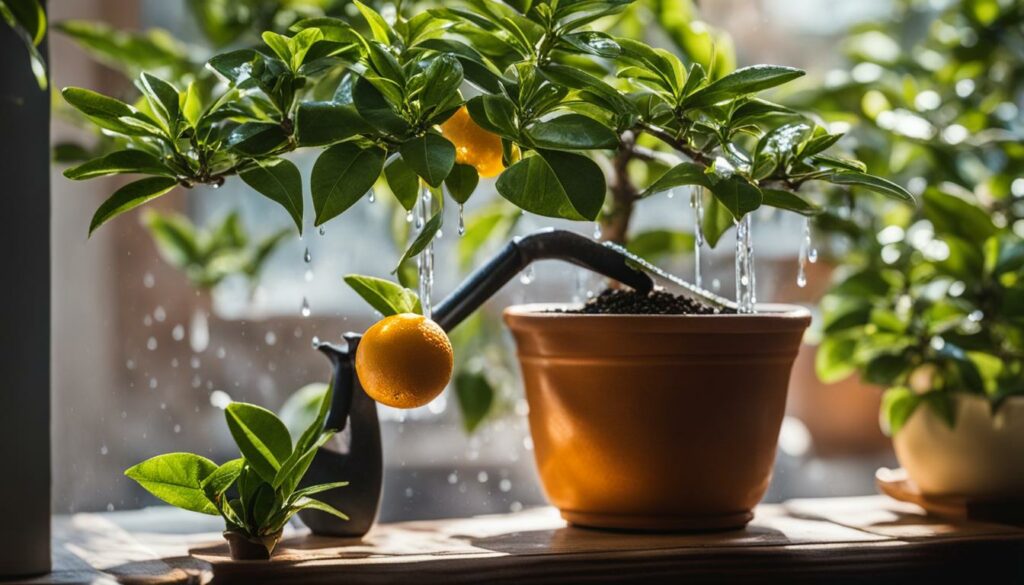
Fruiting Techniques for Citrus Bonsai
Encouraging fruit production in your Citrus Bonsai can be challenging, but with the right techniques, you can achieve optimal results. There are several methods you can use to manipulate flowering and fruiting cycles in your miniature citrus tree.
1. Root Pruning
Root pruning is a technique that involves trimming the roots of the Bonsai tree to encourage better health and optimized fruit growth. By root pruning, you can regulate the supply of water and nutrients to the tree and create a more efficient root system. This method helps to direct the tree’s energy towards fruit production as opposed to continued growth.
2. Fertilization
Using the right fertilizers can support the fruiting of your Citrus Bonsai. Opt for organic fertilizers that supply essential nutrients like potassium, phosphorus, and nitrogen. A high phosphorus fertilizer can stimulate fruiting in the Citrus Bonsai tree. Proper fertilization can increase the number of blossoms that eventually lead to harvesting fruit.
3. Temperature Control
Citrus trees require specific temperature ranges to produce fruit. Citrus Bonsai trees need a warm environment, usually between 50°F to 70°F, to develop fruit. During the flowering period, keep the Citrus Bonsai in an environment with moderate humidity to make sure the flower develops into a fruit.
| Fruiting Techniques | Description |
|---|---|
| Cross-Pollination | Citrus trees, including Bonsai, require cross-pollination to set fruit. You can use a small brush to gently transfer pollen from one flower to another flower within the same Bonsai tree or different Citrus Bonsai trees to help with successful pollination. |
| Flowering Inhibition | If your Citrus Bonsai is too young to start fruiting or has not yet produced enough foliage, you may want to inhibit the flowering process to encourage growth. To do this, remove the developing fruit as soon as you notice them to direct resources to foliage and growth instead of fruiting. |
| Light Alteration | Citrus Bonsai’s flowering and fruit bearing require a certain amount of sunlight. Modifying the amount of light exposure to your tree can help trigger some fruiting. Remember to do this with moderation and start with a small adjustment to avoid stressing the tree. |
By implementing these fruiting techniques, you can help your Citrus Bonsai tree produce healthy and abundant fruit. However, it’s important to remember that fruiting takes time, especially for young trees. Also, some fruiting techniques should only be attempted by experienced Bonsai growers as they require specific knowledge and training.
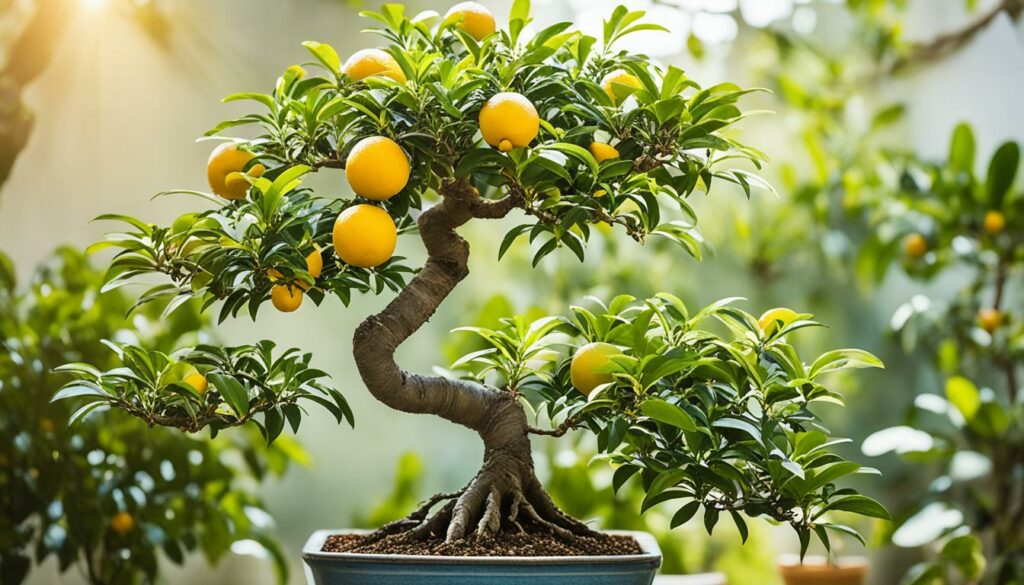
Repotting and Root Care for Citrus Bonsai
Repotting is an essential step in maintaining the health and beauty of your Citrus Bonsai. It is recommended to repot your tree every two to three years, or whenever it outgrows its current container. When you notice the soil becoming compacted, it’s time to repot.
Before repotting, ensure that you have the necessary tools and materials, including a new container, fresh soil, and pruning shears. Start by carefully removing the tree from its current pot and trimming any dead or damaged roots. Then, repot the tree in the new container with fresh soil, and water it generously.
Root care is also critical for the overall health of your Citrus Bonsai. Ensure that your tree has adequate drainage to prevent waterlogging, which can lead to root rot. You can improve drainage by using a well-draining soil mix and adding a layer of rocks or gravel at the bottom of the pot.
Regularly inspect the roots of your Citrus Bonsai to ensure they are healthy and free from pests or diseases. If you notice any issues, take immediate action to address them to prevent further damage to your miniature tree.
Pest and Disease Management for Citrus Bonsai
Your miniaturized citrus trees require proper care and attention to prevent and treat pests and diseases effectively. Here are some common issues that you may encounter and some useful methods to combat them:
Citrus Rust Mite
The Citrus Rust Mite is one of the most common pests that affect Citrus Bonsai. The mites feed on the leaves, causing them to turn yellow and fall off the tree. If left untreated, this pest can cause significant damage. To prevent the Citrus Rust Mite infestation, regularly spray the tree with a citrus oil or insecticidal soap.
Citrus Leaf Miner
The Citrus Leaf Miner is a tiny insect that burrows into the leaves of citrus trees and feeds on the plant’s sap. This pest creates tunnel-like patterns on leaves and causes the leaves to curl up and become distorted. One way to control the Citrus Leaf Miner population is to remove and destroy the affected leaves as soon as you notice them.
Oranges Dogs
Orange Dogs is the larvae of the Swallowtail Butterfly, which feeds on the leaves of citrus trees, including Bonsai. If not managed properly, these pests can cause substantial damage, including defoliation of the tree. To prevent infestation, prune the affected branches, remove all eggs, and use insecticides to control the population.
Citrus Canker
Citrus Canker is a bacterial disease that can cause significant damage to Citrus Bonsai. The disease causes the leaves and fruit to develop lesions and spots, which can weaken the tree, reduce fruiting, and eventually lead to death. To prevent the disease, keep the tree healthy and eliminate any infected plants nearby. If you notice any symptoms, immediately remove the infected leaves and fruit, and treat the tree with copper-based fungicides.
Protect your Citrus Bonsai from potential threats and preserve its beauty by keeping an eye out for these common pests and diseases. Regularly inspect the tree, and take appropriate measures to control and prevent infestations.
Displaying and Showcasing Citrus Bonsai
Now that you have a beautiful Citrus Bonsai, it’s time to showcase it with pride and enhance its beauty. Here are some creative ways to display your miniature citrus tree:
- Place your Citrus Bonsai in a prominent location where it can be seen, admired, and appreciated.
- Use a beautiful and complementary pot that complements your bonsai’s color and shape. It should be slightly larger than the root ball, allowing room for growth.
- Consider a display stand that elevates your citrus tree, making it a focal point in any room or outdoor space.
- Pair your Citrus Bonsai with other miniature plants and succulents to create a visually engaging garden display.
- Highlight the fruiting aspect of your Citrus Bonsai by placing it near other fruiting trees or plants, such as strawberries or blueberries.
Whether you opt for a traditional or modern style, make sure to choose a display method that reflects your personal taste and enhances the beauty of your Citrus Bonsai.
Showcase Fruiting Citrus Bonsai Varieties
| Common Name | Fruit Type | Best for |
|---|---|---|
| Lemon | Lemons | Indoor display |
| Lime | Limes | Outdoor display |
| Orange | Oranges | Small gardens |
| Kumquat | Kumquats | Greenhouse or indoor display |
Use this table to choose a Citrus Bonsai variety that will showcase its fruiting attributes and add a colorful element to your display.
Citrus Bonsai Troubleshooting and Tips
Growing and caring for Citrus Bonsai can be a rewarding but challenging experience. As you embark on your journey to cultivate and nurture these miniature trees, you may encounter various issues that can affect their health and beauty. Here are some common problems and tried-and-true solutions to help you troubleshoot your Citrus Bonsai:
Yellowing Leaves
If your Citrus Bonsai’s leaves are turning yellow, it may indicate overwatering or poor drainage. Check the soil moisture level, and adjust your watering schedule accordingly. To improve drainage, you may need to repot your tree with fresh, well-draining soil. Additionally, ensure that your Citrus Bonsai is getting enough sunlight and that the air humidity levels are not too high.
Branch Dieback
Branch dieback can be caused by various factors, including over-pruning, pests, and diseases. To prevent this issue, avoid over-pruning your Citrus Bonsai and ensure that you are following proper pruning techniques. Inspect your tree regularly for pests and diseases, and treat them promptly using appropriate methods. Additionally, make sure that your Citrus Bonsai is not exposed to extreme temperature fluctuations, which can stress the tree and cause branch dieback.
Pest Infestation
Common pests that can affect Citrus Bonsai include spider mites, scale insects, and mealybugs. To prevent and manage pest infestations, inspect your tree frequently and use appropriate pest control methods. You can use insecticidal soap or neem oil to treat minor infestations. For severe cases, you may need to apply systemic insecticides or seek professional assistance.
Inadequate Fruit Production
If your Citrus Bonsai is not producing fruit, it may be due to inadequate sunlight, improper fertilizer, or incorrect pruning techniques. Ensure that your tree is getting enough sunlight and that you are using appropriate fertilizer for Citrus Bonsai. Only apply fertilizer during active growth periods and follow the recommended dosage. Additionally, avoid over-pruning your tree, as this can limit fruit production.
Tip Burn
Tip burn is a condition where the tips of your Citrus Bonsai’s leaves turn brown and dry. This can be caused by inconsistent watering, high salt levels in the soil, or exposure to dry air. To prevent tip burn, ensure that your tree is receiving adequate moisture and that the soil is not too salty. You can use distilled water to water your Citrus Bonsai, which can help reduce the salt buildup. Additionally, you can increase the humidity levels around your tree by using a humidifier or placing a tray of water near it.
If you encounter other issues with your Citrus Bonsai, consult reputable Bonsai resources and seek professional advice if necessary. Remember to always be patient and attentive to your miniature citrus tree’s needs, and you will be rewarded with its beauty and fragrance for years to come.
Citrus Bonsai: A Living Work of Art
When you think of art, what comes to mind? A painting? A sculpture? How about a living, breathing tree? Citrus Bonsai embodies the essence of art – the combination of creativity, patience, and skill to transform a humble tree into a masterpiece.
Unlike other forms of art that can be completed in a matter of hours or days, Citrus Bonsai requires years of nurturing and care to achieve its full potential. The process of pruning, shaping, and training the tree to maintain its miniature size while maximizing its natural beauty is an art form in and of itself.
But Citrus Bonsai is not just a beautiful addition to your garden or home decor. It also represents a connection to nature and the environment. The bonsai gardener becomes a caretaker of a living, growing organism, developing a deep respect and appreciation for the natural world.
“A tree is an incomprehensible mystery…it defies our understanding and yet we do know that it is good to be near one.” – Libby Houston
By cultivating a Citrus Bonsai, you are not only creating a stunning work of art but also contributing to the preservation of our planet and the fostering of an eco-conscious mindset.
Conclusion
Citrus Bonsai is a unique and fragrant addition to any gardener’s collection. By choosing the right bonsai tree species and utilizing proper pruning and shaping techniques, you can create a botanical masterpiece that embodies the patience, skill, and connection to nature essential to bonsai art.
Remember to keep your miniature citrus tree healthy by adhering to the specific care requirements discussed in this guide, including appropriate watering, sunlight, temperature, and soil considerations. And if you encounter any issues with pests or diseases, be sure to act quickly to prevent further damage and preserve the beauty of your tree.
With dedication and care, you can showcase your Citrus Bonsai in creative and aesthetically pleasing ways. Use your miniature citrus tree as a focal point in your garden or indoor space, and share the beauty of this living art form with others.
Thank you for taking the time to read this comprehensive guide to Citrus Bonsai. We hope that you have found it informative and inspiring as you embark on your journey of cultivating and nurturing these fragrant and beautiful miniature trees.
FAQ
What is a Citrus Bonsai?
A Citrus Bonsai is a miniaturized version of a citrus tree that has been cultivated and trained to grow in a small container. It combines the beauty of bonsai with the functionality of bearing fruit, creating a stunning and practical addition to any garden or indoor space.
What types of citrus trees are suitable for bonsai?
Several citrus tree species can be used for bonsai, including lemon, orange, lime, and mandarin trees. These species are known for their fragrant blooms, glossy foliage, and delicious fruits. You can choose the species that best suits your preferences and the available growing conditions.
How do I care for a Citrus Bonsai?
Citrus Bonsai require adequate sunlight, regular watering, proper fertilization, and well-draining soil. It’s important to monitor the moisture levels, protect them from cold temperatures, and provide sufficient airflow. Additionally, pruning and shaping are essential for maintaining the desired size and form of your Citrus Bonsai.
Can Citrus Bonsai trees bear fruit?
Yes, with proper care, Citrus Bonsai trees can produce fruit. However, it may take several years for a bonsai tree to reach maturity and develop the ability to bear fruit. Proper fertilization, pollination techniques, and environmental conditions play a crucial role in encouraging fruit production.
How often should I repot my Citrus Bonsai?
Citrus Bonsai should be repotted every 2-3 years to refresh the soil and prevent the roots from becoming pot-bound. Spring is generally the best time for repotting, as it allows the tree to recover and establish new roots during the growing season.
How do I prevent pests and diseases on my Citrus Bonsai?
Regularly inspect your Citrus Bonsai for signs of pests such as aphids, scale insects, or mites. Applying organic insecticides and keeping the surrounding area clean can help prevent infestations. Proper watering and good airflow will also reduce the risk of disease. If your bonsai does encounter issues, prompt identification and appropriate treatment are crucial to prevent further damage.
Can I display my Citrus Bonsai indoors?
Citrus Bonsai can be displayed indoors, but they require proper lighting conditions. They need to receive at least 6-8 hours of direct sunlight, so placing them near a south or west-facing window is recommended. You can also use grow lights to supplement natural sunlight and provide the necessary light intensity.
How long does it take for a Citrus Bonsai to become established?
The time it takes for a Citrus Bonsai to become established can vary depending on various factors, including the species, age, and growing conditions. Generally, it may take several years for a bonsai tree to develop a strong root system and reach a level of maturity where it can be considered fully established.
Can I shape my Citrus Bonsai into different forms?
Absolutely! Shaping is an essential part of bonsai cultivation, and you can use various techniques such as pruning, wiring, and bending to create your desired form. However, keep in mind that wiring should be done with caution to avoid damaging the delicate branches of your Citrus Bonsai.
How do I encourage my Citrus Bonsai to flower?
To encourage flowering in your Citrus Bonsai, it’s important to provide the right conditions. This includes sufficient sunlight, proper fertilization with a balanced fertilizer, and ensuring the tree receives the necessary cooling period during winter. Additionally, you can hand-pollinate the flowers to increase the chances of fruit production.
